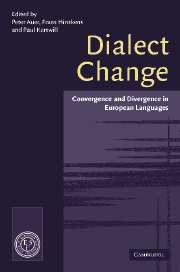Book contents
- Frontmatter
- Contents
- List of maps
- List of figures
- List of contributors
- Preface
- Map
- 1 The study of dialect convergence and divergence: conceptual and methodological considerations
- Part 1 Convergence, Divergence and Linguistic Structure
- Part 2 Macrosociolinguistic Motivations of Convergence and Divergence
- 6 Processes of standardisation in Scandinavia
- 7 The birth of new dialects
- 8 Dialect convergence in the German language islands (Sprachinseln)
- 9 Political borders and dialect divergence/convergence in Europe
- 10 The influence of urban centres on the spatial diffusion of dialect phenomena
- Part 3 Microsociolinguistic Motivations
- References
- Index
10 - The influence of urban centres on the spatial diffusion of dialect phenomena
Published online by Cambridge University Press: 22 September 2009
- Frontmatter
- Contents
- List of maps
- List of figures
- List of contributors
- Preface
- Map
- 1 The study of dialect convergence and divergence: conceptual and methodological considerations
- Part 1 Convergence, Divergence and Linguistic Structure
- Part 2 Macrosociolinguistic Motivations of Convergence and Divergence
- 6 Processes of standardisation in Scandinavia
- 7 The birth of new dialects
- 8 Dialect convergence in the German language islands (Sprachinseln)
- 9 Political borders and dialect divergence/convergence in Europe
- 10 The influence of urban centres on the spatial diffusion of dialect phenomena
- Part 3 Microsociolinguistic Motivations
- References
- Index
Summary
Urban centres play a prominent part in the spatial diffusion of linguistic phenomena. On dialect maps this is usually reflected by the island-like position of urban dialects (sections 1 and 2). A closer examination of this phenomenon reveals that urban dialects display three types of ‘insularity’. Each type will be illustrated by examples from recent sociodialectological literature and from my own investigations in Flanders (section 3). Next we pursue the causes of this urban ‘insularity’ in greater depth; it appears that besides social factors, social-psychological and structural-linguistic ones (may) also play an important role (section 4). The relevance of the last two kinds of factors leads, finally, to a critique of the use of gravity models in geolinguistics (section 5).
Introduction: Patterns of Spatial Diffusion
Social geography has paid a good deal of attention to how innovative phenomena spread across given areas (e.g. Hägerstrand 1967; Brown 1981).Two patterns tend to emerge as the most common modes of diffusion.
The contagious diffusion pattern: innovations spread via social networks, which are bound to have a kind of neighbourhood effect, in the sense that an innovation (including a linguistic innovation) is passed on by means of direct personal contact. The innovation is propagated in waves and step by step.[…]
- Type
- Chapter
- Information
- Dialect ChangeConvergence and Divergence in European Languages, pp. 263 - 284Publisher: Cambridge University PressPrint publication year: 2005
- 69
- Cited by



